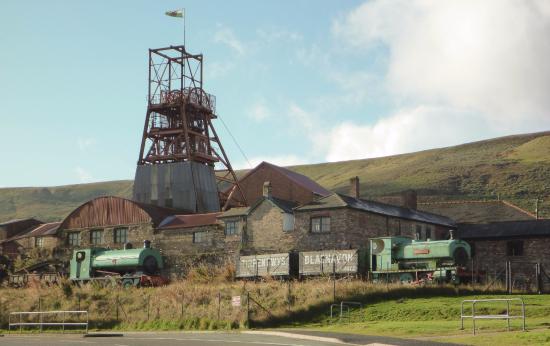Blaenavon Industrial Landscape

BLAENAVON was an important centre of coal mining and iron making in south Wales during the late 18th and early 19th centuries.
The Industrial Revolution in Britain was based on iron and coal, the main products of the south Wales valleys. Production of pig iron in the region grew from 39,600 tons in 1796 to 666,000 tons in 1852, and the iron was used to build railways, factories and engines around the world.
The Blaenavon Ironworks was opened around 1789 and caused development of the mines, quarries and housing. Now a museum, the works was a major centre of iron production using locally mined or quarried iron ore, coal and limestone. Raw materials and products were transported via horse-drawn tramroads, canals and steam railways.
Today, the landscape in and around Blaenavon, at the upper end of the Afon Lwyd valley, Torfaen, includes protected or listed monuments of the industrial processes, transport infrastructure, workers’ housing and other aspects of early industrialisation in south Wales.
The site, situated on the north eastern rim of the south Wales coalfield, is of such historic significance as an industrial landscape formed in the late 18th and early 19th centuries by mining and iron making activities, that Blaenavon Industrial Landscape was made one of only three Welsh UNESCO World Heritage Sites in 2000.
The 3,290 hectares (8,100 acres) site contains the Blaenavon Ironworks and the Big Pit coal mine, surrounded by mines and quarries, manufacturing plant, railways, canal, workers’ housing and social infrastructure.
At the time of inscription as a World Heritage Site many of the elements were vulnerable due to lack of conservation, but since then there has been extensive work on conserving the ironworks, Big Pit and other historic elements.
The Blaenavon Ironworks operated from 1789 to 1902. Today, there are remains of six well-preserved blast furnaces, casting houses, boiler rooms, engine houses, the water balance tower used to raise and lower trams, and workers’ housing around Stack Square.
Big Pit was the last deep coal mine to remain operational in the area and the surface buildings, winding gear and underground workings are still in excellent condition. The mine was worked from around 1860 until 1980. The original pithead buildings have been preserved, including the head frame, winding engine and baths.
The Big Pit Colliery was reopened as a museum in 1983 under the auspices of the National Museum of Wales and a World Heritage Centre was opened in 2008.
There are walks and trails along which visitors may explore the Blaenavon Industrial Landscape with waymarked footpaths following the tracks of the earliest iron railways. The Pontypool and Blaenavon Railway was once an important transport facility. The steam railway has been restored and has a station in the centre of the town.
The Landscape is managed by the Blaenavon Partnership, which involves various authorities, agencies and other bodies and is led by Torfaen County Borough Council. In all, it includes 24 scheduled monuments and 82 listed buildings.